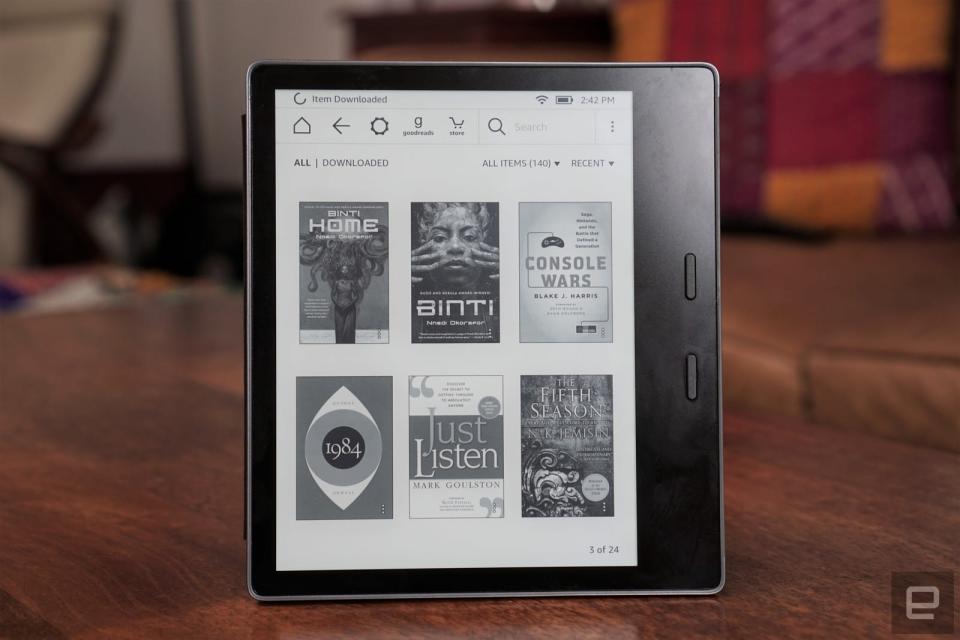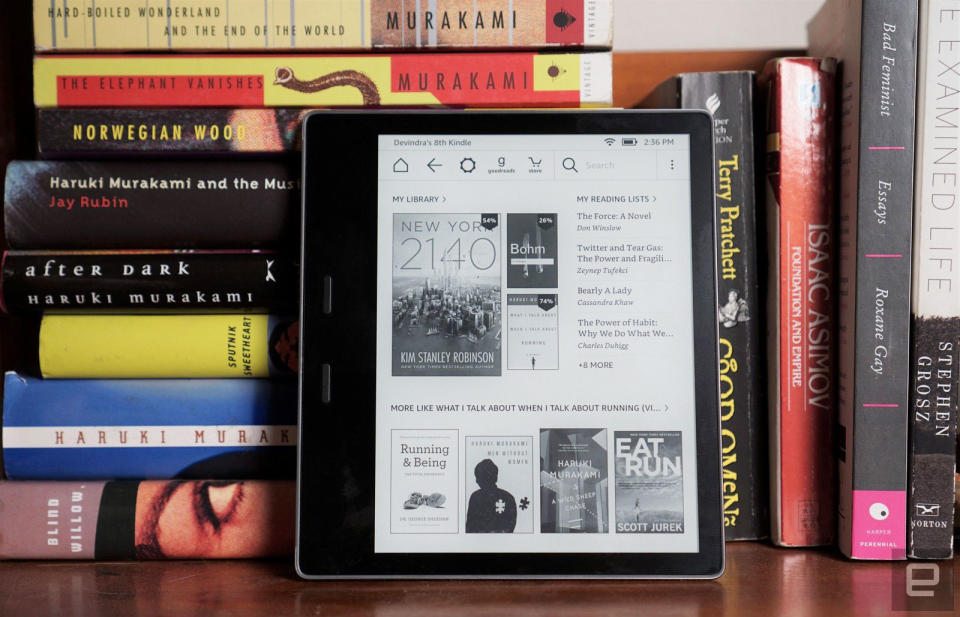Kindle Oasis review (2017): Cheaper, waterproof and a bigger screen
It's a more useful premium e-reader.
Amazon's last Kindle Oasis felt like an e-reader meant for the very rich. It was astoundingly thin and light, but its $290 price made it a tough sell. The new Oasis is still the company's most expensive e-reader, but at $250, it's slightly cheaper than before. It also features a few firsts for Amazon's Kindle lineup: It's waterproof -- something that readers have been begging for for years -- and it has a larger 7-inch screen. While it's still hard to stomach paying so much for a mere e-reader, the new Kindle Oasis makes a stronger case for doing so than before.
Hardware

Take the lopsided design of the last Oasis, make the screen bigger and slap on a metal case, and you've pretty much got the new model. While it's not exactly a fresh look, it feels significantly different from before. Its aluminum case -- another first for Kindles -- is cool to the touch and gives off a sturdy, premium vibe. It still tapers off to a thin 3.4-millimeter edge, while its thicker side makes it easy to grip with one hand.
After years of staring at 6-inch e-ink screens, the Oasis's 7-inch display feels like a breath of fresh air. It still offers a crisp 300-pixel-per-inch (ppi) resolution, but it can hold 30 percent more text than before. Twelve LEDs also make its backlighting more uniform than on cheaper Kindles. The larger screen is long overdue -- the last time we saw Amazon experiment with e-ink beyond six inches, it was with the ill-fated Kindle DX. That device was bulky, hard to use, and cost a whopping $489 when it was released in 2009.

As you can imagine, with a bigger screen comes more weight. The new Oasis clocks in at 194 grams, whereas the last model was an astoundingly light 131 grams. It's a shame Amazon backtracked its design a bit, but I'd imagine many consumers might prefer having a larger, more modern-looking screen instead of a lighter e-reader.
The more expansive shell also let Amazon stuff in a larger battery, giving the new Oasis five to six weeks of reading time. The previous model lasted "only" two weeks on its own, and it relied on a bundled case for an additional six weeks of power. Speaking of cases, you won't find one in the box with the new Oasis. That's probably a big reason why the new e-reader is cheaper than before. If you really need one, you can pick up a waterproof cloth case for $45, or a leather one for $60. Neither of them provide extra power, though.
The Oasis is also waterproof, with an IPX8 rating -- a feature that might make it an instant purchase for bathtub and beach readers. Amazon claims it'll survive sitting in up to two meters of freshwater for 60 minutes.
In use

As soon as I got my hands on the revamped Oasis, I got to work on my reading-list backlog. For the most part, that meant diving back into Kim Stanley Robinson's latest science fiction opus, New York 2140. Almost immediately, I noticed that the book was a bit easier to read on the larger screen. The text felt like it had more room to breathe, and I was able to spend more time engrossed in the story without having to worry about flipping pages.
When I needed to hop to the next page, the Oasis handled it a fraction of a second faster than the last model. That's nothing to get too excited about, but it's still nice to see Amazon making progress with e-ink refresh rates. Beyond the larger and faster screen, though, text on the Oasis still looks about the same as Amazon's $120 Paperwhite. The additional LEDs give the backlight a slightly more effervescent glow, but it's not significantly better than before.
While it wasn't difficult to hold the Oasis for lengthy reading sessions, I found myself missing the impossibly light weight of its predecessor. The metal case also has some surprisingly sharp edges around the edges. It's not the sort of thing that could cut you, but it makes some noticeable impressions on your skin when you hold it for a while. Simply put, the new Oasis just isn't as comfortable as the last model. Even the cheaper Paperwhite rests more easily in your hands.

Due to the lack of any warm beaches, pools or large soaking tubs nearby, I tested the Oasis's waterproof feature the only way I could: by dunking it in a container full of water. It survived full immersion for several minutes, so I can't imagine it'll have any issues if you accidentally drop it in your bath. Perhaps that's just an expected feature today, when plenty of smartphones are also waterproof. But as someone who's protected my Kindles with Ziploc bags over the years, I still found it impressive.
The new Oasis is also the first Kindle with Audible support built in. To listen to audiobooks, though, you have to connect the e-reader to a Bluetooth speaker or headphones. While it sounds like a practical feature on paper, though, I found it to be pretty pointless. Audible customers are already used to playing titles from their phones; who would ever want to do that from their e-reader? Sure, the new Oasis lets you easily jump between text and Audible modes without having to find your place again, but Amazon's audiobooks can already synchronize with their Kindle counterparts across multiple devices. Audible support is also coming to Amazon's entry-level e-readers eventually, which doesn't make it seem so special on the Oasis.

I found the new Kindle's accessibility upgrades to be far more useful than audiobook integration. You can invert the text and background colors on the screen, for example, which makes the words white atop a sea of black. I found that particularly helpful for reading at night, since my eyes are very light sensitive. It could also be useful if you're worried about how late-night reading might affect your sleep. Amazon says it had to build some custom E Ink hardware to make that feature work. (I've definitely never seen it on an e-reader before.)
There are also a few features appearing in the Kindle Oasis that will eventually head over to earlier models. You can now choose different bold settings for fonts, which makes them easier to read, as well as a wider variety of font sizes. If you want your e-books to look more like printed titles, with text aligned along the left margin, you'll appreciate the Oasis's new ragged-right alignment view as well.
In my four days of testing the Kindle Oasis, the battery meter has gone down around 10 percent. It's also worth noting that I didn't turn off WiFi or cellular connectivity either. I can't tell if the Kindle would actually last the five to six weeks Amazon claims, but if this discharge rate holds, it could conceivably go for a total of 40 days.
Pricing and the competition

The $250 Oasis comes with 8GB of storage, but you can also get up to 32GB for $280. If, for some reason, its Audible support appeals to you, that larger model would make more sense. You can also get the Oasis with LTE connectivity and 32GB of space for $350.
If you just want a solid e-ink screen with a simple backlight, the $120 Kindle Paperwhite is still the best deal in Amazon's lineup. It's worth spending the extra $40 from the basic Kindle so you don't have to worry about strapping on a reading light. As for the $200 Kindle Voyage ... well, I'm still not sure why that one exists. If you want something beyond what the Paperwhite offers, it makes sense to go all the way to the Oasis.
As for non-Amazon options, you can get a refurbished version of Barnes & Noble's Nook GlowLight Plus for $80. But given that that bookseller has stopped making new models, I wouldn't bet on that e-book platform being around for much longer.
Wrap-up

Once again, Amazon has delivered a premium Kindle for the lucky few. While it's expensive, the new Oasis is at least cheaper than the last one. It also has some useful features that you won't find on any other Kindle. If you have the means, it's the best e-reader option on the market. For everyone else, though, the Kindle Paperwhite remains a great deal.











